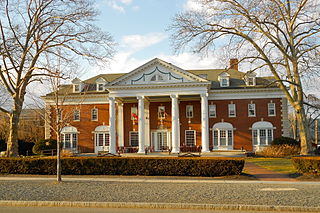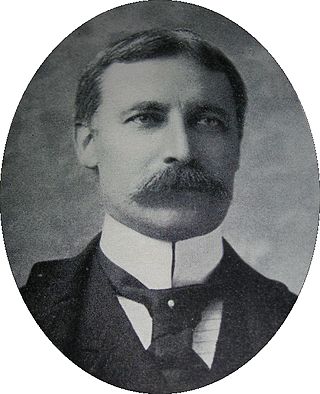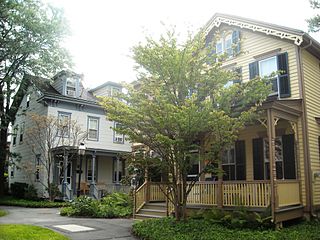
Princeton University is a private Ivy League research university in Princeton, New Jersey. Founded in 1746 in Elizabeth as the College of New Jersey, Princeton is the fourth-oldest institution of higher education in the United States and one of the nine colonial colleges chartered before the American Revolution. The institution moved to Newark in 1747, and then to the current site nine years later. It officially became a university in 1896 and was subsequently renamed Princeton University.

Campus Club was one of the undergraduate eating clubs at Princeton University. Located on the corner of Washington Road and Prospect Avenue, Campus was founded in 1900. It was one of the eating clubs that abandoned the selective bicker process to choose members non-selectively, a status it held for over twenty years.

The Princeton Quadrangle Club, often abbreviated to "Quad", is one of the eleven eating clubs at Princeton University that remain open. Located at 33 Prospect Avenue, the club is currently "sign-in," meaning it permits any second semester sophomore, junior or senior to join. The club's tradition of openness is demonstrated as far back as 1970, when Quadrangle became one of the first coeducational eating clubs.

Colonial Club is one of the eleven current eating clubs of Princeton University in Princeton, New Jersey, United States. Founded in 1891, it is the fifth oldest of the clubs. It is located on 40 Prospect Avenue.

The Ivy Club, often simply Ivy, is the oldest eating club at Princeton University, and it is "still considered the most prestigious.” It was founded in 1879 with Arthur Hawley Scribner as its first head.

Princeton Tower Club is one of the eleven eating clubs at Princeton University in Princeton, New Jersey, United States, and one of seven clubs to choose its members through a selective process called bicker. Tower is located at 13 Prospect Avenue between the university-run Campus Club and the Cannon Club; it currently has a membership of approximately 215.

The Princeton Charter Club is one of Princeton University's eleven active undergraduate eating clubs located on or near Prospect Avenue in Princeton, New Jersey, United States.

Nassau Hall, colloquially known as Old Nassau, is the oldest building at Princeton University in Princeton, Mercer County, New Jersey, United States. In 1783 it served as the United States Capitol building for four months. At the time it was built in 1756, Nassau Hall was the largest building in colonial New Jersey and the largest academic building in the American colonies.

Tiger Inn is one of the eleven active eating clubs at Princeton University in Princeton, New Jersey. Tiger Inn was founded in 1890 and is one of the "Big Four" eating clubs at Princeton, the four oldest and most prestigious on campus. Tiger Inn is the third oldest Princeton Eating Club. Its historic clubhouse is located at 48 Prospect Avenue, Princeton, New Jersey, near the Princeton University campus. Members of "T.I." also frequently refer to the club as "The Glorious Tiger Inn."

Princeton Terrace Club is one of eleven current eating clubs at Princeton University in Princeton, New Jersey, United States. Terrace Club was founded in 1904 and is located at 62 Washington Road. It is the sole Princeton eating club located off Prospect Avenue.

Moses Taylor Pyne, was an American financier and philanthropist, and one of Princeton University's greatest benefactors and its most influential trustee.

Cap and Gown Club, founded in 1890, is an eating club at Princeton University, in Princeton, New Jersey, United States. Colloquially known as "Cap", the club is one of the "Big Four" eating clubs at Princeton. Members are selected through a selective process called bicker. Sometimes known as "the Illustrious Cap and Gown Club," it was the first of the currently selective eating clubs to accept women. Though personalities of eating clubs certainly change throughout the years, Cap and Gown is described in F. Scott Fitzgerald's This Side of Paradise as "anti-alcoholic, faintly religious and politically powerful."

The eating clubs at Princeton University are private institutions resembling both dining halls and social houses, where the majority of Princeton upperclassmen eat their meals. Each eating club occupies a large mansion on Prospect Avenue, one of the main roads that runs through the Princeton campus, with the exception of Terrace Club which is just around the corner on Washington Road. This area is known to students colloquially as "The Street". Princeton's eating clubs are the primary setting in F. Scott Fitzgerald's 1920 debut novel, This Side of Paradise, and the clubs appeared prominently in the 2004 novel The Rule of Four.

Cloister Inn is one of the undergraduate eating clubs at Princeton University in Princeton, New Jersey, United States.

Prospect House, known also as just Prospect, is a historic house on the Princeton University campus in Princeton, Mercer County, New Jersey, United States. Built in 1851, it is a fine example of the work of architect John Notman who helped popularize Italianate architecture in America. Notable residents include Woodrow Wilson during his tenure as president of the university. The building now serves as a faculty club. It was designated a National Historic Landmark in 1985 for its architecture and historic associations.

The Princeton Historic District is a 370-acre (150 ha) historic district located in Princeton, New Jersey that was listed on the U.S. National Register of Historic Places in 1975. It stretches from Marquand Park in the west to the Eating Clubs in the East, from the Princeton Cemetery in the north to the Graduate College in the south. The district encompasses the core parts of the campuses of the Princeton Theological Seminary and Princeton University. It also includes the business district centered on Nassau Street and many historic homes, both mansions in the western section and more humble dwellings in the Witherspoon/Jackson neighborhood. Notable churches within the district include Nassau Presbyterian Church, Trinity Episcopal, Nassau Christian Center, and the Princeton University Chapel. The district is home to seven of Princeton's nine, and New Jersey's fifty-eight, National Historic Landmarks, the largest concentration of such sites in the state.

The Peacock Inn is a historic restaurant and inn in Princeton, New Jersey. The building itself dates to the 18th century and was originally located at the corner of Nassau Street and University Place. During the American Revolution it was the home of Jonathan Deare, and played host to members of the Continental Congress when they met in nearby Nassau Hall. It was moved to its current location in 1875 by famed archaeologist and Olympic athlete William Libbey. Joseph and Helen O'Conner purchased the property in 1911 and opened the Peacock Inn, naming it after an inn in Derbyshire, England. The Inn has 16 guest rooms but is most known for its restaurant, consistently rated one of the finest in the state.

Cannon Dial Elm Club, also known as Cannon Club, is one of the historic Eating Clubs at Princeton University. Founded in 1895, it completed its current clubhouse in 1910. The club closed in the early 1970s and later merged with Dial Lodge and Elm Club to form Dial, Elm, Cannon (DEC), which closed its doors in 1998. In 2011 DEC reopened, now bearing the name Cannon Dial Elm Club, using its historic clubhouse, which had served as the home for the Office of Population Research during the club's hiatus.

The Nassau Club of Princeton, New Jersey, founded in 1889 by, among others, Woodrow Wilson as a town-and-gown club to bring the townspeople and the University faculty together, is now a private social club. It moved into its current location in 1903. The clubhouse was originally built in 1813-14 as the home of Samuel Miller, the second professor of the Princeton Theological Seminary, on land belonging to his father-in-law, Continental Congressman Jonathan Dickinson Sergeant. Sergeant had built a large house on the site shortly before the American Revolution but it was burned down during the British occupation prior to the Battle of Princeton.
Sally Frank sued the three all-male eating clubs at Princeton University in 1978 for denying her on the basis of her gender. Over ten years later, in 1990 the eating clubs were defined as "public accommodation" and court ordered to become co-ed thanks to Sally Frank, her attorney Nadine Taub and the Women's Rights Litigation Clinic of Rutgers Law School. The eating clubs argued that they were completely private and separate from the university, giving them the right to sex discrimination. After many rounds in the courts, this argument eventually failed. The winning argument stated that the clubs were in fact not separate, and instead functioned as an arm of the university itself. This meant that the clubs were in the end covered by New Jersey's anti-discrimination law and forced to admit women.























